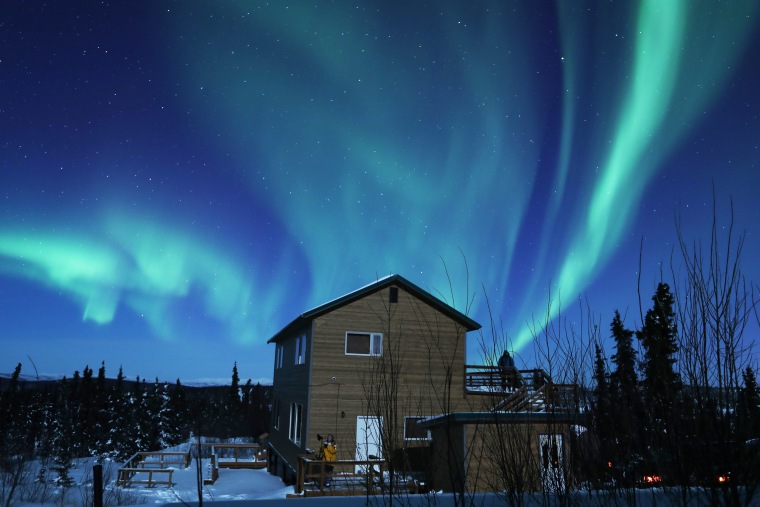The northern lights may light up skies at high latitudes this week, though likely not in cities in the lower 48 states, as previously forecast.
An early forecast published by the University of Alaska Fairbanks Geophysical Institute initially indicated that, weather permitting, the northern lights could be visible Thursday in more than a dozen states, including ones at midlatitudes. The projection was updated Monday evening to show that auroras may be visible in Alaska and parts of several Canadian provinces and territories, such as Alberta, Manitoba, Quebec and the Northwest Territories, as well as a few U.S. cities at higher latitudes.
“Recent predictions of auroral activity visible much further south than Alaska have been making the rounds,” Don Hampton, a research associate professor at the Geophysical Institute, said in an email. “This prediction, several days ahead of time, is based on models run by the Space Weather Prediction Center, a part of NOAA, and located in Boulder, Colorado. The Geophysical Institute does not make long-term auroral predictions. Our aurora forecast is from SWPC.”
He noted that the models are based on a limited number of input measurements that track activity on the sun and the space between the sun and the Earth.
“There are only a few satellites and instruments dedicated to collecting these data, so the models typically have a wide range of predictions since the observations are relatively sparse,” Hampton wrote. “While large solar storms can be seen leaving the vicinity of the sun, and their direction and speed can be estimated, once they leave the local solar vicinity they cannot be tracked. During this time the solar storms can be slightly diverted or even reduced, and the final impact on Earth’s magnetic field may be different than predicted.”
Lt. Bryan Brasher, a project manager at the Space Weather Prediction Center, said it regularly produces a 27-day outlook of solar activity and that, roughly two weeks ago, it did include the possibility of a moderate disturbance of Earth’s magnetic field.
But these outlooks only give a rough idea of what could play out, he said, adding that aurora forecasts can only be reliably made when the hallmarks of solar storms are actually observed on the sun. Early projections often change or are refined by observing features of the sun as they rotate into view.
About a week ago, the center downgraded its assessment based on more up-to-date monitoring of the sun’s activity.
“Now we’re not predicting anything on the 12th or 13th,” he said. “Nothing out of the ordinary.”
Brasher said he’s not sure what caused the erroneous northern lights forecast to take off online, but added that it’s still very challenging to produce long-term predictions of space weather.
“At no point in time was anyone saying anything false,” he said. “There was a prediction out there that could have been valid. But ultimately, the prediction that was offered was already going to be a very minor storm to begin with.”
The northern lights, also known as the aurora borealis, are triggered by storms that erupt from the sun. The solar storms eject clouds of charged particles into space that occasionally rain down on Earth’s magnetic field. The colorful neon lights are created when the charged particles collide with atoms and molecules in the planet’s upper atmosphere, according to the National Oceanic and Atmospheric Administration.
Auroras appear most commonly as shimmering displays of green light, but reddish, pink, blue and purple hues can also be seen, depending on the composition and density of the atmosphere.
The northern lights are typically seen at high latitudes, but strong solar storms can intensify the displays, making them visible in places farther south than normal.
Auroras are best viewed from locations that are clear and dark, according to the Geophysical Institute. If conditions are clear and the northern lights are particularly bright, they can be seen from up to 600 miles away, according to the NOAA. People should pick a spot away from city lights, the agency said, and aim for “within an hour or two of midnight (between 10 PM and 2 AM local time).”
The Space Weather Prediction Center maintains an aurora dashboard that provides short-term forecasts of the northern lights and where they will be visible.
Brasher said that while people in midlatitude states may feel disappointed this time around, there may be chances to catch the northern lights in the near future, as the sun ramps up activity.
“The sun goes through these 11-year cycles between maximum activity and minimum activity, and we are approaching the time of maximum activity,” he said. “It’s pretty much a statistical certainty that we will have more opportunities in the mid-latitude states to see auroras.”
CLARIFICATION (July 10, 2023, 11:34 p.m. ET): A previous version of this article detailed a forecast published by the University of Alaska Fairbanks that said auroral displays were expected to be visible from many U.S. cities in the lower 48 states. The university updated the forecast to remove most of those cities.

